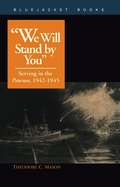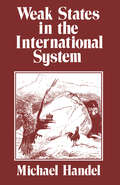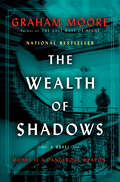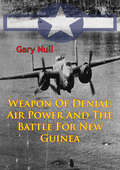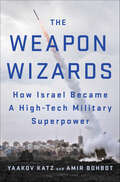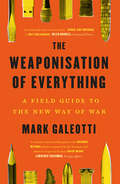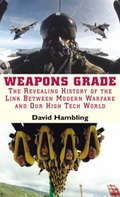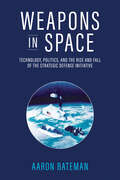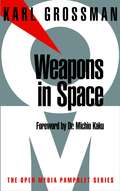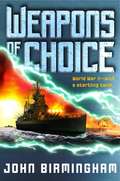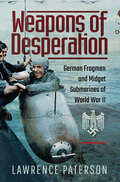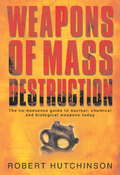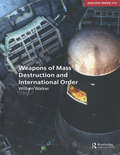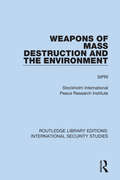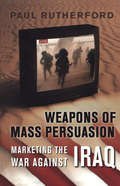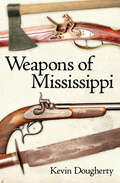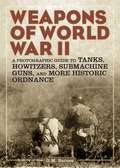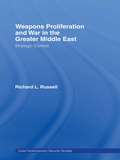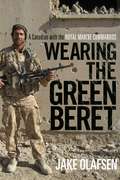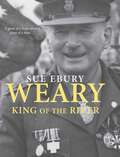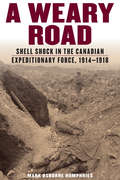- Table View
- List View
We Will Stand by You
by Theodore C. MasonAn enlisted radioman recalls his years of action in the Pacific with candor and humor.
Weak States in the International System
by Michael I. HandelThis work defines weak states and their strengths and weaknesses. It examines why they are weak and their position in different international systems as well as their economic positions.
The Wealth of Shadows: A Novel
by Graham Moore&“A thriller of a different kind—with an unlikely band of economists and bureaucrats working in the shadows to save the world.&”—Charles Frazier, New York Times bestselling author of Cold MountainAn ordinary man joins a secret mission to bring down the Nazi war machine by crashing their economy in this thrilling novel based on a true story, from the Academy Award–winning screenwriter of The Imitation Game and bestselling author of The Last Days of Night.1939. Ansel Luxford has everything a person could want—a comfortable career, a brilliant spouse, a beautiful new baby. But he is obsessed by a belief that Europe is on the precipice of a war that will grow to consume the world. The United States is officially proclaiming neutrality in any foreign conflict, but when Ansel is offered an opportunity to move to Washington, D.C., to join a clandestine project within the Treasury Department that is working to undermine Nazi Germany, he uproots his family overnight and takes on the challenge of a lifetime.How can they defeat the enemy without firing a bullet?To thwart the Nazis, Ansel and his team invent a powerful new theater of battle: economic warfare. Money is a dangerous weapon, and Ansel&’s efforts will plunge him into a world full of peril and deceit. He will crisscross the globe to broker backroom deals, undertake daring heists, and spar with titans of industry like J.P. Morgan and the century&’s greatest economic mind, Britain&’s John Maynard Keynes. When Ansel&’s wife takes a job with the FBI to hunt for spies within the government, the need for subterfuge extends to the home front. And Ansel discovers that he might be closer to those spies than he could ever imagine.The Wealth of Shadows is a mind-expanding historical novel about the mysterious powers of money, the lies worth telling to defeat evil, and a hidden war that shaped the modern world.
The Weapon from Beyond
by Edmond HamiltonMorgan Chane was an Earthman by parentage, but he had been born on the pirate-world Varna, whose heavy gravity had developed strength and incredibly quick reflexes in him. When he was old enough, he joined the raider-ships that looted the starworlds, and fought side by side with the dreaded Starwolves of Varna. But then there was a fight among them. Chane killed their leader, and the other Starwolves turned on him. He barely got away alive - wounded near death, his Starwolf pursuers following him across the galaxy. And there was nowhere he could seek refuge, for no world would lift a hand to save one of the hated Starwolves.
Weapon Of Denial: Air Power And The Battle For New Guinea [Illustrated Edition]
by Gary NullIncludes over 12 photos and mapsGen. Douglas MacArthur, commander of Pacific forces in World War II, viewed the Battle of the Bismarck Sea as a disaster for the Japanese and a triumph for the Allies. In that great air-sea confrontation, U.S. and Australian air forces proved that air power could be decisive in preventing the resupply of ground troops by sea. Months of torturous warfare in the jungles of New Guinea had left Japanese troops vulnerable to disease and starvation. In the end, Allied airmen were able to break Japan's grip on New Guinea and end its threat to Australia through the innovative and aggressive use of air power. MacArthur's strength lay in a dedicated and courageous band of airmen who could attack enemy ships from all directions at any time.
The Weapon Wizards: How Israel Became A High-Tech Military Superpower
by Yaakov Katz Amir Bohbot"A lively account of Israel's evolving military prowess...if The Weapon Wizards were a novel, it would be one written by Horatio Alger; if it were a biblical allegory, it would be the story of David and Goliath." —The New York Times Book ReviewFrom drones to satellites, missile defense systems to cyber warfare, Israel is leading the world when it comes to new technology being deployed on the modern battlefield. The Weapon Wizards shows how this tiny nation of 8 million learned to adapt to the changes in warfare and in the defense industry and become the new prototype of a 21st century superpower, not in size, but rather in innovation and efficiency—and as a result of its long war experience. Sitting on the front lines of how wars are fought in the 21st century, Israel has developed in its arms trade new weapons and retrofitted old ones so they remain effective, relevant, and deadly on a constantly-changing battlefield. While other countries begin to prepare for these challenges, they are looking to Israel—and specifically its weapons—for guidance. Israel is, in effect, a laboratory for the rest of the world. How did Israel do it? And what are the military and geopolitical implications of these developments? These are some of the key questions Yaakov Katz and Amir Bohbot address. Drawing on a vast amount of research, and unparalleled access to the Israeli defense establishment, this book is a report directly from the front lines.
The Weaponisation of Everything: A Field Guide to the New Way of War
by Mark GaleottiAn engaging guide to the various ways in which war is now waged—and how to adapt to this new reality Hybrid War, Grey Zone Warfare, Unrestricted War: today, traditional conflict—fought with guns, bombs, and drones—has become too expensive to wage, too unpopular at home, and too difficult to manage. In an age when America threatens Europe with sanctions, and when China spends billions buying influence abroad, the world is heading for a new era of permanent low-level conflict, often unnoticed, undeclared, and unending. Transnational crime expert Mark Galeotti provides a comprehensive and ground-breaking survey of the new way of war. Ranging across the globe, Galeotti shows how today&’s conflicts are fought with everything from disinformation and espionage to crime and subversion, leading to instability within countries and a legitimacy crisis across the globe. But rather than suggest that we hope for a return to a bygone era of &“stable&” warfare, Galeotti details ways of surviving, adapting, and taking advantage of the opportunities presented by this new reality.
Weapons Grade: Revealing the Links Between Modern Warfare and Our High Tech World
by David HamblingPredicting how the business world might evolve is itself a multi-million-dollar business. Plenty of gurus, academics and snake-oil salesmen will tell you all about the future for a price. What the experts overlook is that the future is already here. Chances are the products and services of tomorrow are available now to a very limited clientele at a top-secret research institute near you. Throughout history, war and its threat have driven innovation and the uptake of new technology from the ancient swordsmiths who pioneered the use of iron to the Pentagon bureaucrats who funded the early internet. And since 1945 the relationship between military needs and modern business has grown ever closer. As well as telling the story of technology transfer in the past, Hambling explores the cutting edge of modern military research. Throughout he seeks to identify the technologies that will transform business and society in the decades to come. If history does repeat itself, Weapons Grade will be a book about the future of business with a difference: rather than learning more about the shape of current preoccupations, Hambling's readers will discover something about the future of business.
Weapons Grade: Revealing the Links Between Modern Warfare and Our High Tech World
by David HamblingPredicting how the business world might evolve is itself a multi-million-dollar business. Plenty of gurus, academics and snake-oil salesmen will tell you all about the future for a price. What the experts overlook is that the future is already here. Chances are the products and services of tomorrow are available now to a very limited clientele at a top-secret research institute near you. Throughout history, war and its threat have driven innovation and the uptake of new technology from the ancient swordsmiths who pioneered the use of iron to the Pentagon bureaucrats who funded the early internet. And since 1945 the relationship between military needs and modern business has grown ever closer. As well as telling the story of technology transfer in the past, Hambling explores the cutting edge of modern military research. Throughout he seeks to identify the technologies that will transform business and society in the decades to come. If history does repeat itself, Weapons Grade will be a book about the future of business with a difference: rather than learning more about the shape of current preoccupations, Hambling's readers will discover something about the future of business.
Weapons in Space: Technology, Politics, and the Rise and Fall of the Strategic Defense Initiative
by Aaron BatemanA new and provocative take on the formerly classified history of accelerating superpower military competition in space in the late Cold War and beyond.In March 1983, President Ronald Reagan shocked the world when he established the Strategic Defense Initiative (SDI), derisively known as &“Star Wars,&” a space-based missile defense program that aimed to protect the US from nuclear attack. In Weapons in Space, Aaron Bateman draws from recently declassified American, European, and Soviet documents to give an insightful account of SDI, situating it within a new phase in the militarization of space after the superpower détente fell apart in the 1970s. In doing so, Bateman reveals the largely secret role of military space technologies in late–Cold War US defense strategy and foreign relations.In contrast to existing narratives, Weapons in Space shows how tension over the role of military space technologies in American statecraft was a central source of SDI&’s controversy, even more so than questions of technical feasibility. By detailing the participation of Western European countries in SDI research and development, Bateman reframes space militarization in the 1970s and 1980s as an international phenomenon. He further reveals that even though SDI did not come to fruition, it obstructed diplomatic efforts to create new arms control limits in space. Consequently, Weapons in Space carries the legacy of SDI into the post–Cold War era and shows how this controversial program continues to shape the global discourse about instability in space—and the growing anxieties about a twenty-first-century space arms race.
Weapons in Space (Open Media Series)
by Michio Kaku Karl GrossmanWeapons in Space examines how the United States is forcing forward--in violation of international treaties--to militarize space. Based on excerpts from U.S. government documents, award-winning investigative journalist Karl Grossman outlines the U.S. military's space doctrine, its similarity with the original Stars Wars scheme of Ronald Reagan and Edward Teller, and the space-based lasers, hypervelocity guns, and particle beams it plans to deploy in its mission to "dominate" earth.Grossman shows the intimate link between the militarization and the nuclearization of space, and follows the flow of billions of U.S. tax dollars to the corporations that research and develop weapons for space. His book explains the Outer Space Treaty and gives a history of the Global Network Against Weapons and Nuclear power in Space: what it is doing, what it plans to do--and what the reader can do to challenge U.S. plans to turn the heavens into a war zone.
Weapons of Choice: A Novel of the Axis of Time (Axis of Time #1)
by John BirminghamOn the eve of America's greatest victory in the Pacific, a catastrophic event disrupts the course of World War II, forever changing the rules of combat. . . . The impossible has spawned the unthinkable. A military experiment in the year 2021 has thrust an American-led multinational armada back to 1942, right into the middle of the U.S. naval task force speeding toward Midway Atoll--and what was to be the most spectacular U.S. triumph of the entire war. Thousands died in the chaos, but the ripples had only begun. For these veterans of Pearl Harbor--led by Admirals Nimitz, Halsey, and Spruance--have never seen a helicopter, or a satellite link, or a nuclear weapon. And they've never encountered an African American colonel or a British naval commander who was a woman and half-Pakistani. While they embrace the armada's awesome firepower, they may find the twenty-first century sailors themselves far from acceptable.Initial jubilation at news the Allies would win the war is quickly doused by the chilling realization that the time travelers themselves--by their very presence--have rendered history null and void. Celebration turns to dread when the possibility arises that other elements of the twenty-first century task force may have also made the trip--and might now be aiding Yamamoto and the Japanese.What happens next is anybody's guess--and everybody's nightmare. . . .From the Trade Paperback edition.
Weapons of Desperation: German Frogmen and Midget Submarines of World War II
by Lawrence PatersonAs the Third Reich headed for destruction, German ingenuity in the naval field turned to unconventional weapons – midget submarines, radio-controlled explosive boats, and various forms of underwater sabotage. This is one of the last un-chronicled areas of World War II naval history and this well-known author describes how, facing overwhelming odds, German sailors – most of them volunteers – mounted attacks that were little better than suicide missions. Judged by their effect on the Allied advance, their successes were slight, but there seems to have been no collapse of morale and the indomitable bravery of those involved makes riveting reading. Pieced together from fragmentary sources, this largely untold story uncovers some of the most desperate operations of the War.
Weapons of Mass Deception: The Uses of Propaganda in Bush's War on Iraq
by John Stauber Sheldon RamptonWeapons of Mass Deception reveals: How the Iraq war was sold to the American public through professional P.R. strategies. "The First Casualty": Lies that were told related to the Iraq war. Euphemisms and jargon related to the Iraq war, e.g. "shock and awe," "Operation Iraqi Freedom," "axis of evil," "coalition of the willing," etc. <P><P>"War as Opportunity": How the war on terrorism and the war on Iraq have been used as marketing hooks to sell products and policies that have nothing to do with fighting terrorism. "Brand America": The efforts of Charlotte Beers and other U.S. propaganda campaigns designed to win hearts overseas. "The Mass Media as Propaganda Vehicle": How news coverage followed Washington's lead and language. <P>The book includes a glossary -- "Propaganda: A User's Guide" -- and resources to help Americans sort through the deceptions to see the strings behind Washington's campaign to sell the Iraq war to the public.
Weapons of Mass Destruction: The no-nonsense guide to nuclear, chemical and biological weapons today
by Robert HutchinsonA history of weapons of mass destruction from the First World War to the Gulf War - and beyond.When Tom Lehrer sang 'We'll all go together when we go', the world was gripped by fear of nuclear holocaust: the ultimate endgame of every Cold War powerplay. With the collapse of the Soviet Union, the threat was assumed to have gone away. But Libya, Iraq, Iran and North Korea are building weapons of mass destruction. The next live Scud missile launch could signal the next Hiroshima. Robert Hutchinson investigates the history of weapons of mass destruction, from biological warfare during World War I to the atomic weapons of World War II and the Cold War. He reveals that Russia did indeed build the 'Doomsday' nuclear missile system featured in DR STRANGELOVE, but not until the 1980s: and it is still switched on! Chemical weapons remain the 'poor man's nuke'. And as the attack on the Tokyo subway demonstrated, weapons of mass destruction are now available to terrorist organizations as well as 'rogue' nation states.
Weapons of Mass Destruction and International Order (Adelphi series #370)
by William WalkerFirst Published in 2005. How should the 'problem of order' associated with weapons of mass destrcution be understood and addressed today? Have the problem and its solution been misconceived and misrepresented, as manifested by the problematic aftermath of Iraq War? Has 9/11 rendered redundant past international ordering strategies, or these still discarded at our own peril? These are questions explored in this Adelphi Paper.
Weapons of Mass Destruction and the Environment (Routledge Library Editions: International Security Studies #23)
by SipriThe effects of weapons of mass destruction cannot be contained, either spatially or temporally, are unpredictable, discriminate poorly between combatants and civilians, and are highly disruptive of ecosystems. This book, first published in 1977, examines several WMD and analyses the extent and duration of environmental damage to be expected from them. Chapters are devoted to the ecological impacts of nuclear weapons, chemical and biological weapons, and geophysical and environmental weapons.
Weapons of Mass Persuasion
by Paul RutherfordWith nearly sixty percent of Americans initially against a pre-emptive war without sanction from the United Nations, and even higher anti-war numbers in most other nations of the world, the 2003 war against Iraq quickly became an enormous public relations challenge for the George W. Bush administration. The subject of Weapons of Mass Persuasion is a war in which American patriotism became so mired in commercial jingoism that the demarcations between entertainment and political conduct disappeared completely.In this engaging and disturbing book, Paul Rutherford shows how the marketing campaign for the war against Iraq was constructed and carried out. He argues that not only was the campaign a new chapter in the presentation of real-time war as pop culture, but that its deeper implications have now come to constitute part of the history of modern democracy. Situating the war against Iraq within an existing tradition of war as narrative, spectacle, and, more broadly, commodity, Rutherford offers a brief overview of the history of civic advertising and propaganda, then examines in detail the different dimensions of three weeks of war presented to North Americans as it became a branded conflict, processed and cleansed to appeal to the well-established tastes of veteran consumers of popular culture.Including incisive analyses of visual material - speeches, editorial cartoons, and media political commentary, but particularly news reports of such sound bite events as the bombing of Baghdad, the toppling of the Hussein statue, and the rescue of captured soldier Private Jessica Lynch - as well as extensive polling data from around the world and interviews with the actual consumers of war, Weapons of Mass Persuasion chronicles the making of a Hollywood war: fast-paced and heroic, pitting the forces of good against the forces of evil to achieve a triumphant, sanitized, and commodified outcome. Not since Naomi Klein's No Logo have the gods of marketing and the art of commercialism been so thoroughly disrobed. Disclaimer: Images removed at the request of the rights holder.
Weapons of Mississippi
by Kevin DoughertyMississippians have long found the need for an arsenal of interesting, lethal, and imaginative weapons. Native Americans, frontier outlaws, antebellum duelists, authorities and protestors in the civil rights struggle, and present-day hunters have used weapons to survive, to advance causes, or to levy societal control. In Weapons of Mississippi, Kevin Dougherty examines the roles weapons have played in twelve phases of state history. Dougherty not only offers technical background for these devices, but he also presents a new way of understanding the state’s history-through the context and development of its weapons. Chapters in the book bring the story of Mississippi’s weapons up to date with a discussion of the modern naval shipbuilders on the Coast and interviews with hunters keen to pass on family traditions. As Mississippi progressed from a sparsely populated wilderness to a structured modern society, management of weaponry became one of the main requirements for establishing centralized law and order. Indians, outlaws, runaway slaves, secessionists, and night riders have all posed challenges to the often better-armed authorities. Today, weapons unite Mississippians in the popular pastime of hunting deer, turkey, dove, rabbit, and even bear. In the state’s social and cultural character, a shared lore and knowledge of hunting crosses age, racial, and economic lines. Weapons, once used for mere survival, have transformed into instruments masterfully crafted for those harvesting the state’s abundant game.
Weapons of Peace
by Peter D. JohnstonWhat If the Nazis Developed the Atom Bomb First? In this novel inspired by two true stories from the Second World War, a young British nurse and a seasoned American negotiator, both plagued by remorse, try to change the course of history—and their own lives. Recovering from gunshot wounds and confined to an ancient English castle, America's top negotiator shares the secrets of his interrupted mission and his craft with the only person he dares to trust—a young British nurse with a troubled past. When she proves to be an exceptional student of his laws of influence, he urges her to help him complete his mission: Hitler has an atom bomb, and his scientists must be persuaded to undermine their own creation. Weapons of Peace races from an ancient English castle and a bizarre killing in Washington, D.C., to a scorched atomic test site in Germany and hidden passages forged under Berlin by resisters plotting to murder Hitler.Johnston's expert hand blends real-world historical material with heart-pounding action, unforgettable characters, and precious insights into influence and how the Nazis negotiated their way to power and kept it -- a thought-provoking thriller that immerses us in one of history's most pivotal moments."You won't want to sleep until you've read the very last page . . . like The Da Vinci Code . . . buckle up for non-stop action and deceit—with an ending that will leave you breathless." -- Keven Fletcher, author of When It Matters Most"'Brilliantly crafted . . . Johnston writes with the historical realism of Alan Furst or Ken Follett, and the intellectual breadth and clarity one would expect from the author of Negotiating with Giants." -- Barbara J, Falk
Weapons of World War II: A Photographic Guide to Tanks, Howitzers, Submachine Guns, and More Historic Ordnance
by G. M. BarnesWorld War II not only marked the end of a terrifying time in Europe, but also the dawning of many technological breakthroughs. In Weapons of World War II, written by the Chief of Research and Engineering Office of Ordnance, G.M. Barnes discusses the various weapons used during the war. Such topics include: Small arms and small arms ammunition Aircraft armament Ammunition Artillery Tanks, gun motor carriages, and motor transport. And more!With over a 150 vintage black and white photos, this book is a must-have for any history buff with more than just a passing interest in how the war was fought.
Weapons Proliferation and War in the Greater Middle East: Strategic Contest (Contemporary Security Studies)
by Richard L. RussellThis important new book explores the strategic reasons behind the proliferation of nuclear, biological and chemical weapons as well as ballistic missile delivery systems in the Greater Middle East. It examines the uses and limitations of chemical weapons in regional combat, ballistic missile warfare and defenses, as well as Iran's drive for nuclear weapons and the likely regional reactions should Tehran acquire a nuclear weapons inventory. This book also discusses Chinese assistance to WMD and ballistic programs in the Greater Middle East. Finally, this book recommends policy options for American diplomacy to counter the challenges posed by WMD proliferation. This essential study prepares the ground for the challenges facing the international community.Richard Russell is a professor at the National Defense University's Near East-South Asia Center for Strategic Studies in Washington, DC. He also teaches at the Security Studies Program at Georgetown University. He previously served as a political-military analyst at the CIA.
Wearing the Green Beret: A Canadian with the Royal Marine Commandos
by Jake OlafsenIn 2004, Jake Olafsen signed up for the Royal Marines Commandos. He left everything behind at home in Canada on the basis of a spur-of-the-moment decision. The Royal Marines have the toughest and longest basic training of any infantry unit in the world. For Olafson, this meant eight months of wet and cold in England and Wales. It was hell, but he came out with the four Commando qualities that the corps look for: courage, determination, unselfishness, cheerfulness in the face of adversity.Olafsen went on to serve for four years as a Commando in the Royal Marines, an elite military unit based in the United Kingdom. He went to Afghanistan twice: in 2006, he went to confront the Taliban in Helmand Province for six months, and in 2007, he was sent to do it all over again. His story is filled with good experiences, like the sense of accomplishment, patriotism, and camaraderie, and the opportunity to travel the world. But all good things come at a price. The sacrifices he made for the Corps are significant; he has killed the enemy and he has buried his friends. And in telling his story, Olafsen hopes that he can make sense of it all. This is an honest, gutsy story about the mud and the blood, the triumphs and the tragedies.From the Hardcover edition.
Weary: King of the River
by Sue EburyIn a wartime nightmare of starvation, disease, brutality and death, Sir Edward 'Weary' Dunlop's courage and compassion made him an Australian legend. During more than three years as a surgeon in the notorious work camps and vast hospital camps along the Burma-Thailand railway, he worked tirelessly to save lives and get men home to their families. He confronted his captors fearlessly; three times he was tortured and taken out to be executed, only to be reprieved at the last moment. Fellow prisoners regarded him as 'a symbol of hope and a rock'. This new, illustrated biography of Weary includes more than 150 images as well as never-before-published material about his betrayal to his captors. Weary was the quintessential Australian all-rounder-brilliant student, outstanding sportsman and irrepressible larrikin who dedicated his life to caring for people. When he died in July 1993, 10 000 people stood silently to farewell the most honoured medical man in Australia. By then, this great humanitarian's influence had spread far beyond the veteran community to embrace the entire nation.
A Weary Road: Shell Shock in the Canadian Expeditionary Force, 1914-1918
by Mark Osborne Humphries<p>More than 16,000 Canadian soldiers suffered from shell shock during the Great War of 1914 to 1918. Despite significant interest from historians, we still know relatively little about how it was experienced, diagnosed, treated, and managed in the frontline trenches in the Canadian and British forces. <p>How did soldiers relate to suffering comrades? Did large numbers of shell shock cases affect the outcome of important battles? Was frontline psychiatric treatment as effective as many experts claimed after the war? Were Canadians treated any differently than other Commonwealth soldiers? A Weary Road is the first comprehensive study to address these important questions. Author Mark Osborne Humphries uses research from Canadian, British, and Australian archives, including hundreds of newly available hospital records and patient medical files, to provide a history of war trauma as it was experienced, treated, and managed by ordinary soldiers.</p>
